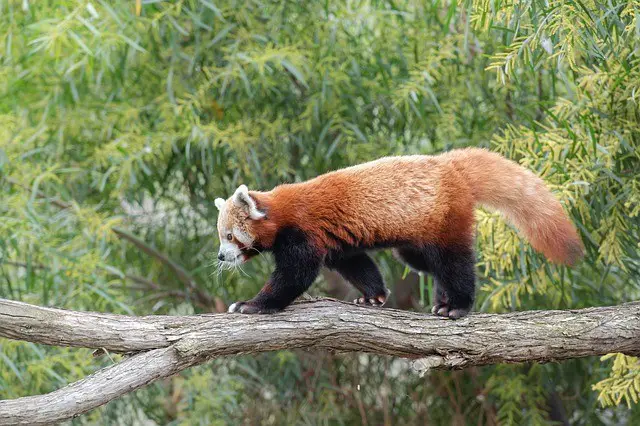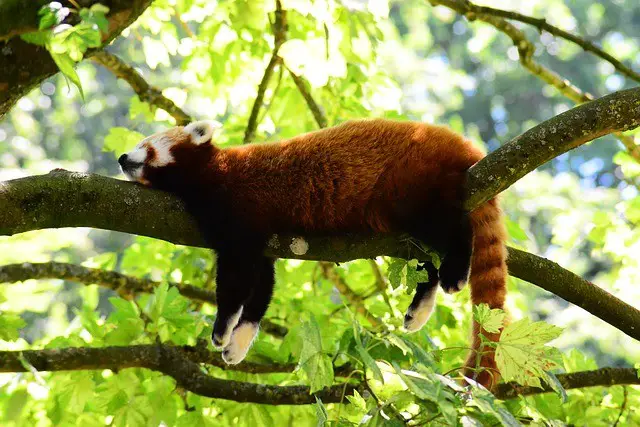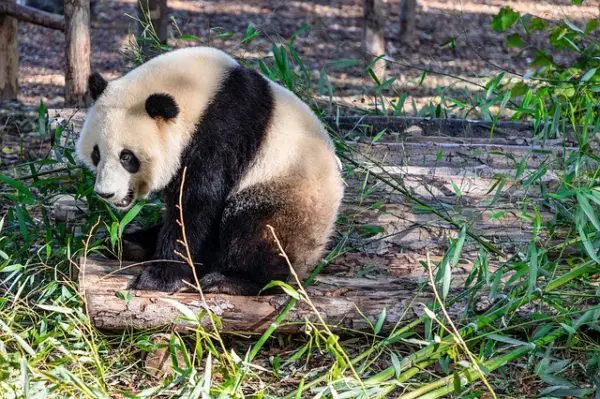Red Pandas are adorable animals. They are endangered and efforts are required to save them. One of the best ways to save endangered animals is to spread awareness about them and teach our kids why these animals are important and why there is a need to save them from extinction. Here at Kidz Feed, we have gathered a complete set of Red Panda Facts For Kids that will provide all the Red Panda Information For Kids that they need to know about this amazing animal. Kids are going to learn about its type, scientific classification, species, characteristics, sound, color, size, body parts, speed, habitat, range, diet, ecosystem, food chain, reproduction, babies, life cycle, adaptation, population, threats, predators, conservation efforts and many other interesting facts about Red Pandas.
Red Panda Facts For Kids
1. What Is A Red Panda
- The red panda is an arboreal (living in trees) mammal of a domestic cat size.
- It is indigenous to Southwestern China and Eastern Himalayas.
- It belongs to its own unique family Ailuridae.
- It is also known as the “Firefox” and is the logo of the web browser Mozilla Firefox.

2. What Type Of Animal Is A Red Panda
- The red panda is a mammal type of animal.
3. Red Panda Scientific Name
- “Ailurus fulgens” is the scientific name of the red panda.
4. Red Panda Classification – Red Panda Taxonomy
- The following is the scientific classification of the red panda:
| Kingdom | Animalia |
| Phylum | Chordata |
| Sub-phylum | Vertebrata |
| Class | Mammalia |
| Order | Carnivora |
| Family | Ailuridae |
| Genus | Ailurus |
| Species | Ailurus fulgens |
| Sub-species |
|
5. Red Panda Species
- The red panda species is further divided into two extant subspecies:
- Western red panda (Ailurus fulgens fulgens), and
- Styan’s red panda (Ailurus fulgens styani).
- Since 2008, the red panda species are on the IUCN Red List of Threatened Species.
6. What Family Is The Red Panda In – Red Panda Family
- Red panda belongs to the family Ailuridae.
- The red panda is the only extant (living today) species of this family.
7. What Is A Red Panda Related To – Red Panda Relatives
- The red panda belongs to the family Ailuridae and its closest relatives are:
- Skunks and stink badgers (members of the family Mephitidae)
- Weasels, otters, ferrets, badgers, and martens (members of the family Mustelidae)
- Raccoons, olinguitos, and ringtails (members of the family Procyonidae)
- All the above animals and red panda share a super-family Musteloidea.
8. Is The Red Panda Related To The Giant Panda
- No, the red panda is not related to the giant panda.
- Red panda belongs to its own unique family Ailuridae, while giant panda belongs to the family Ursidae.
- They only share the same habitat and also eat the same kind of food, that is bamboo.
9. Red Panda Characteristics – Red Panda Features- Red Panda Traits
- In size, the red panda is slightly larger than a domestic cat.
- Their body is covered with soft and dense fur.
- The upper side of the body has red-brown color, the underside and legs have dark blackish color, and the face and ears have a white color.
- They have a long, shaggy, and ringed tail like that of a raccoon.
- Red pandas have shorter front legs due to which they have a waddling gait (movement of the limbs).
- The claws of the red panda are semi-retractile and have a false thumb like that of the giant panda.
- The red panda is arboreal and mainly nocturnal (active at night and inactive or sleeping during the day) in nature.

10. What Sound Does A Red Panda Make – Red Panda Sounds
- Red pandas make several different sounds for communication including squeals, huff quacks, tweeting, and twittering.
- In case of any danger or threat, they also grunt or hiss.
11. What Does A Red Panda Look Like – Red Panda Appearance
- The appearance of the red panda is somewhat like a big cat.
- However, its body marking is like a panda and the tail marking is like a raccoon.
12. What Color Is A Red Panda – Red Panda Colors
- Red pandas have a red-brown fur color.
- The underside of the body and legs have dark blackish fur color, while the face and ears have a white color.
- Over the eyes, red pandas have a marking of red-brown color which looks like a mask.
- Beneath the eyes, the red-brown marking is like the tear marking.
- They have a long, shaggy, and dense tail with alternating ring patterns of light and dark brown color.
13. What Is The Size Of A Red Panda – Red Panda Size
- Red pandas have a body length of 20 to 26 inches and weigh from 12 to 20 pounds.
- They have 12 to 20 inches long tails.

14. How Much Does A Red Panda Weigh – Red Panda Weight
- The weight of a male red panda ranges between 8.2 to 13.7 pounds (3.7 to 6.2 kg) and of a female between 6.6 to 13.2 pounds (3 to 6 kg).
15. How Long Is A Red Panda – Red Panda Length – How Tall Is A Red Panda – Red Panda Height
- The head and body length of the red panda is from 20 to 26 inches (o.5 to 0.6 meters).
- While the length of the tail is from 12 to 20 inches (0.3 to 0.5 meters).
16. Red Panda Teeth
- The red panda has 38 sharp teeth arranged in two powerful jaws.
- They have sharp incisors and canine teeth at the front and strong molars at the backsides of their jaws.
- The teeth structure of the red panda is particularly designed for tearing and chewing bamboo.
17. Red Panda Paws
- Red pandas have strong, sharp, and semi-retractile paws capable of pulling back and in just like that of cat paws.
- They also do not have paw pads.
- Like the giant panda, they have an extra thumb known as the “false thumb”, which is an enlarged carpal or wrist bone.
- The feet soles of red pandas are covered with thick fur, which provides insulation in the snowy habitat and protects them from slipping on the wet tree branches.
- Besides climbing, red pandas also use their paws for defending themselves.
18. Red Panda Tail
- Red pandas have a long, shaggy tail of approximately 12 to 20 inches in length.
- Their tails have about 12 alternating light and dark rings.
- The tail of a red panda resembles the tail of a raccoon.
- Tail not only provides them balance during climbing but also a shield during the harsh cold climates and camouflage against predators.
19. Red Panda Ears
- Red pandas have two large pointed ears covered with dense fur of white borders.
- Their ears resemble a cat’s ears.
- Red pandas have an excellent sense of hearing.
20. Red Panda Lifespan – Red Panda Life Expectancy
- The average lifespan of red pandas in the wild is between 8 and 10 years.
- In captivity, they live for up to 14 and a maximum of 15 years.
21. How Fast Is A Red Panda – Red Panda Speed
- The fastest speed of the red panda is up to 38 km/h (24 miles per hour).
22. Where Is Red Panda Found – Red Panda Habitat Facts
- Red pandas are found in the forests of the Eastern Himalayas and Southwestern China.
- They share the habitat of the giant panda.
- They live between the elevation of 7,200 and 17,500 feet (3,220 to 3,610 meters).
- Their habitat has a moderate temperature between 10 and 25 ℃ (50 and 77 ℉) with a minute annual change.
- They like to live in the mixed conifer and deciduous forests of mountains and especially prefer the dense understories of bamboo.
Red Panda In The Wild – Red Panda Natural Habitat
- In the wild, red pandas are found only in the forests of Himalaya and South Western China.23.
- They are native to the Himalayan mountain range, which is their natural habitat.

Red Panda Habitat Climate – Red Panda Biome
- A biome is a large ecological region on the earth’s surface occupied by a large community of animals and plants that are specially adapted for living in that environment.
- Red pandas live in the temperate forest biome of the Himalayas where the climate persistently remains cool and rainy throughout the year.
- The annual rainfall in their climate is approximately 140 inches.
- Snowfall also occurs sometimes.
- The temperature remains between 10 and 25 ℃ (50 and 77 ℉).
- As red pandas are better equipped with cold climates rather than hot, so they stay comfortable if the temperature is 1 to 5 ℃.
- In the case of high humidity in the air, red pandas in captivity can not tolerate a temperature of more than 80 ℉ and suffer heat stress.
Red Panda Habitat Map

23. Red Panda Range
- The range of the red panda begins from the lower hills of western Nepal and terminates on the east side to the Quinling mountains in China, which is their easternmost limit.
- Their range covers the areas of several countries like southern Tibbet, Sikkim, and Assam in India, Bhutan, and the northern mountains of Myanmar (Burma).
- While in China, their range covers the mountainous regions of several provinces including; the Hengduan Mountains (in Sichuan province), the Gongshan Mountains (in Yunnan province), and the Qinling Mountains (in Shaanxi province).
Where Is Red Panda Found In India – Red Panda In India
- In India, red pandas are found in Darjeeling and Kalimpong (northern West Bengal), Sikkim, Meghalaya, and Arunachal Pradesh.
- In the following national parks, red pandas are found and can be easily spotted:
- Singalila National Park, Darjeeling, West Bengal
- Noera Vally National Park, Darjeeling, West Bengal
- Nokrek National Park, Meghalaya
- Balphakram National Park, Meghalaya
- Namdapha National Park, Arunachal Pradesh
- Khangchendzonga National Park, Sikkim
Himalayan Red Panda
- Both subspecies of the red panda are Himalayan, as they are native to the Eastern Himalayas and Southwestern China.
- In the wild, they do not found anywhere else in the world.
24. Red Panda Country Of Origin – Red Panda Origin
- The country of origin of the red panda is unknown.
- However, the fossils of the extinct red panda species Parailurus anglicus have been discovered from the east (in China) to the west (in the United Kingdom).
- The first known written record of the red panda exists in a Chinese scroll of the 13th century, in which a hunting scene is portrayed between the red panda and the hunters.
25. Red Pandas In Captivity
- Red pandas do well in captivity and are held in zoos throughout the world.
- Before 1992, there were 300 red pandas in 85 institutions all over the world.
- There were 182 red pandas alone in the zoos of North America before 2001.
- In 2006, the international studbook or herdbook (breed registry) listed more than 800 red pandas in worldwide zoos.
- The Rotterdam Zoo (Netherland) has the largest number of red panda captive births all over the world.

26. Red Panda Nest
- A female red panda builds a nest before giving birth to offspring.
- The location of their nest is usually a hollow tree or a rock fissure.
- A few days before giving birth, a female red panda starts collecting material like grass, leaves, and brushwood to build a nest.
- She frequently moves her cubs among several nests.
- She also keeps all the nests clean.
- Cubs live in the nests for approximately 90 days.
27. Red Panda In A Tree
- The red panda is an arboreal animal and can climb trees just like a monkey.
- They spent most of their lifetime in trees and even sleep in tree branches.
28. Red Panda Ecosystem – What Role Does The Red Panda Play In Its Ecosystem
- Red pandas play an important role in its ecosystem.
- Everything in an ecosystem has a special connection and causes an impact on each other.
- Red panda eats bamboo and insects, so if red pandas become extinct, the occurrence of bamboo may decline or spread and could exert a negative effect on the environment.
- Conservation biologists believe that the red panda is an indicator of the overall ecological health of the Eastern Himalayan forest eco-region.
- Their presence in greater numbers and flourishing there represents the well-being state of those forests.
29. Red Panda Food Chain
- In the food chain of the red panda, the producers are bamboo which gets energy from the sun and prepares its food itself.
- The red panda is a consumer and eats bamboo as a large part of its diet.
- The predators of the red panda are the snow leopard and marten.
30. What Do Red Pandas Eat – Red Pandas Diet
- Red pandas’ food includes bamboo, mushrooms, lichens, acorns, roots, birds, some small mammals such as mice and other rodents, birds’ eggs, flowers, and berries.
- They mostly consume bamboo, which makes up two-third part of their diet.
- They also sometimes consume insects and fish.
- In captivity, they are also observed eating leaves of maple and mulberry trees, flowers, and birds.
- In San Diego Zoo, they are fed with bamboo, leaf eater biscuits, dry dog food, yams, and fruits such as apples and grapes.
Red Panda Nutrition
- Red pandas obtain most of their nutrition from bamboo.
- Just like the giant panda, red pandas also can’t digest cellulose, due to which they have to consume a large quantity of bamboo for survival.
- As compared to bamboo leaves, bamboo shoots are more easily digestible.
- In summer and autumn, red pandas show the highest digestibility levels due to the abundance of bamboo shoots.
- While in spring, their digestibility level is intermediate and becomes lowest in winter due to the lack of bamboo shoots.
- As their diet has poor nutrition value, they mostly consume the high-quality sections of the bamboo plant, such as shoots and newly emerged leaves, in a large quantity.
- The daily quantity of their food is up to 3.3 lb (1.5 kg) fresh leaves and 8.8 lb (4 kg) fresh shoots of bamboo.
- For the maximum nutrient intake, the food passes extremely rapidly (in approximately 2 to 4 hours) through their entire digestive tract.
Red Panda Eating Bamboo
- When eating bamboo, red pandas strip the green bamboo leaves from their stems through their mouths.
- They put food in their mouth directly or sometimes use their front paws for bringing food to their mouth.
- They then chew and swallow it.
31. Red Panda Breeding – Red Panda Reproduction
- Red pandas become fully sexually mature at the age of 2 to 3 years.
- The mid of January to early March is their mating season.
- The gestation period is 112 to 158 days.
- Before giving birth, a female red panda built a nest from leaves and grasses in a hollow tree or a rock.
- From mid-June to late July is their delivery month.
- The newborns are called cubs and are born deaf and blind.
32. How Many Babies Can A Red Panda Have
- Red pandas usually have 1 to 2 cubs.
- The maximum number of cubs a red panda gives birth at a time is 4.
33. Red Panda Baby Facts – Newborn Red Panda – Red Panda Cub
- Baby pandas are called cubs.
- The newborn cubs are deaf and blind.
- Each cub has a body weight from 110 to 130 grams.
- Just after birth, the mother cleans her cubs by licking them with her tongue.
- The mother also recognizes each cub by its distinct smell.
- During the first week, the mother spends 60 to 90% of her time with her cubs and feeds them with her milk.
- After one week, the mother then spends much of her time outside and feeds the cubs after every few hours.
- She also moves her cubs among several nests to protect them from predators.
- After 18 days, the cubs begin opening their eyes.
- At the age of 3 months, the bodies of cubs become completely covered with adult fur of cinnamon color.
- At this age, they also begin eating bamboo and other solid food.
- At the age of about six to eight months, the cubs are weaned.
- The cubs stay with their mothers until she gives birth for another time.
- The mortality rate of baby red pandas is very high, which is approximately 86%.
How Much Does A Baby Red Panda Weigh
- The newborn baby panda weighs from 3.9 to 4.6 oz (110 to 130 g).
34. Male Red Panda
- A male red panda is called a “boar”.
- They have a body weight of 8.2 to 13.7 lb (3.7 to 6.2), slightly heavier than females.
- Males have no interest in raising cubs.
35. Female Red Panda
- A female red panda is called a “sow”.
- She has a bodyweight of about 6.6 to 13.2 lb (3 to 6 kg).
- Female raises the cubs alone and reproduces about every year.
36. What Is The Life Cycle Of A Red Panda – Red Panda Life Cycle
- Red pandas reach complete sexual maturity at the age of 2 to 3 years.
- However, they can reproduce at the age of only 18 months.
- The cubs are born after the gestation period of 112 to 158 days.
- Mothers nurse her cubs for 6 to 8 months.
- The cubs stay with their mother until she reproduces again.
- The average lifespan of red pandas is between 8 and 10 years.
- The maximum known lifespan is 15 years.
37. Red Panda Behavior Facts
- The red panda is a solitary animal and spent most of its life alone except in the mating season.
- It is also a territorial animal and patrols its territory with urine marks and with a secretion from its anal gland that has a weak musk-like smell.
- They usually keep quiet and make only some tweeting, twittering, and whistling sounds for communication.
- A red panda is nocturnal (active at night) as well as crepuscular (active at the twilight, the period of dawn and dusk) in nature.
- They spend much of their daytime sleeping and become active in the hours of late afternoon and early evening.
- When sleeping, a red panda usually wraps up its tail over the face in cold seasons to stay warm, while on hot days it lies straightly on a tree branch with legs loosely hanging.
- Just like a cat, when a red panda awakes it cleans its fur, licking its front paws, and rubbing its torso, back, and sides.
- They are also observed rubbing their bellies and backs with the sides of rocks or trees.
- In case of feeling danger or threat, they try to flee. However, if they can no longer escape, they stand upright on their hind limbs to make themselves look bigger and use their sharp-edged claws on their front paws for defense.
38. Red Panda Adaptations
- Red pandas have many adaptations, which enable them to survive in their habitat.
- They have a smaller bodyweight, which enables them to walk even on tiny tree branches and become inaccessible to predators.
- Red pandas have an excellent dental system comprised of 38 teeth arranged in two jaws. With sharp incisors and canines at the front and molars at the backside, it is perfect for tearing and chewing bamboo and other types of food.
- They have a “false thumb” on their front paws which is an enlarged wrist bone. This thumb helps hold and grasp food as well as the tree branches while climbing.
- Their paws are completely coated with dense and wooly fur, which reduces heat loss in extremely cold climates. It also protects them from slipping while climbing wet tree branches.
- To drink water, they dip their paws in the water and then suck it.
- They have extremely sharp and semi-retractable claws, which make the climbing process fast and easier.
- When they climb down a tree, they descend in the “head first” direction. They can rotate their ankles, which permits the hind claws to grasp the tree branch firmly and control their descending movement. It also provides a fast departure after reaching the ground.
- The dense fur of the red pandas is another adaptation, which protects against excessive heat loss and keeps them warm in their extremely cold climate.
- Their tail also has very dense fur. When sleeping in clod season, red pandas wrap around their tail to stay warm. Long-tail also provides them balance during climbing. The alternating white and red-brown ringed pattern of the tail provides them camouflage against predators.
- Red pandas also can stand on their hind limbs for a maximum time of up to 10 seconds.
39. Red Panda Population Statistics
- It is difficult to estimate the exact population of the red pandas due to their shy and nocturnal nature, which makes its observation difficult.
- So in the wild, their population figures are not estimated on the direct count but rather determined through the estimation of the population density.
- The estimation of the worldwide population of the red panda ranges from 2,500 to between 5,000 and 6,000 individuals.
- In 1991, their estimated total population in China was between 3,000 and 7,000 individuals.
- In 2001, their estimated population in the wild in India was between 5,000 and 6,000 individuals.
- In Nepal, it is estimated as a few hundred individuals, while no record exists about their population in Burma and Bhutan.
40. Red Panda Endangered Facts – Red Panda Endangered Species Facts – Red Panda Extinction Facts
- The red panda is on the IUCN Red List of endangered species.
- They are endangered because of habitat loss, illegal hunt, lower birth rate, and higher mortality rate of the cubs.
- The total estimated population of the red panda in the wild is less than 10,000 individuals and is continuously declining.
- The animal use only half of its entire potential habitat area of 55,000 sq mi (142,000 km²).
- Deforestation is the major factor in its endangeredness due to which their populations become fragmented and they have minimum chances of breeding.
Why Are Red Pandas Endangered
- Red pandas are endangered because of:
- Loss of habitat due to deforestation
- Poaching or illegal hunting
- Illegal pet trade
- Diseases
- Accidental trapping
How Long Has The Red Panda Been Endangered
- The red panda was listed as an endangered species on the IUCN Red List in 2008.
- Before, it was on the list of “Vulnerable” species.
Red Panda Threats
- Threats to the survival of the red panda include:
- Habitat loss due to deforestation is a major threat to the red panda. Deforestation not only degrades their habitat but also makes it fragmented led to fewer chances of their breeding. In India, habitat loss is a primary threat to their survival.
- In China, the biggest threat to red pandas is poaching and illegal hunting. They are hunted for their high valued fur which is used in the ceremonies of the local culture. In Southwestern China, the fur of the red panda’s tail is used for making hate; the “good-luck charm hat” that the local newly-weds wear.
- Naturally, red pandas have an extremely low birth rate, while their mortality rate in the wild is very high.
41. Red Panda Predators
- The natural predators of the red panda are snow leopard and members of the family Mustelidae, like wolverine, weasels, and badgers which especially prey the vulnerable cubs of the red panda.
- The human being is the biggest predator of the red panda, which hunts it for its fur and the illegal pet trade.
42. Red Panda Protection – Red Panda Conservation Status
- The red panda is listed as an endangered species on the IUCN Red List.
- Their population has been decreased by about 50% in the last 18 years.
- Red pandas are protected in all the countries which cover their habitat range, and their hunt is illegal there.
- There are 35 protected areas in China, which cover approximately 42.4% of the red pandas’ habitat.
- In India, there are 20 protected areas in Sikkim, Arunachal Pradesh, and Western Bengal; such as Namdapha, Khangchendzonga, and Singalila National Parks. All these areas have a possible or known population of the red pandas and a coordinated policy for their conservation.
- In Nepal, the known populations of the red pandas are found in Sagarmatha, Langtang, Makalu Barun, Annapurna Conservation Area, Kanchenjunga Conservation Area, Rara National Park, and Dhorpatan Hunting Reserve.
- In Bhutan, 5 protected areas support the population of the red pandas.
- In Myanmar (Burma), there are 26 protected areas in which the red panda population is occurring in at least one area.
43. Is A Red Panda A Panda
- A red panda is not a giant panda, which is also called just a panda.
- A red panda is called a panda because of eating bamboo, having dense fur, and sharing the habitat of the giant panda.
44. Is A Red Panda A Raccoon
- No, a red panda is not a raccoon.
- However, it has several similarities with the raccoon such as the ringed tail.
- Both the species also the same share super-family and are relatives of each other.
45. Is A Red Panda A Mammal
- Yes, a red panda is a mammal and mothers feed their newborn offspring with their milk.
46. Is A Red Panda A Carnivore
- Red pandas are classified as carnivores because of their ancestors, which were carnivores, and due to their carnivores-like dental structure.
- However, besides some small mammals, birds, and some insects, they eat nothing of animal sources.
47. Is A Red Panda A Herbivore
- Yes, a red panda is a herbivore as it consumes about 80 to 90% of the food of the plant origin, such as bamboo (which is their major diet), flowers, berries, roots, and fruits.
- However, it is also somewhat an omnivore, as it also eats eggs, birds, and some small mammals.
48. Red Panda Vs Raccoon – Red Panda And Raccoon
- The red panda and raccoon are entirely different animal species. The following are some similarities and dissimilarities between them:
| Characteristics | Red panda | Raccoon |
| Family | Ailuridae | Procyonidae |
| Class | Mammalia | Mammalia |
| Native region | Eastern Himalayas and Southwestern China | North America |
| Coat color | Redish-brown | Grayish |
| Tail | Long and shaggy with alternating light and reddish-brown ringed patterns | Long and shaggy with alternating ringed patterns of light grey and black colors |
| Behavior | Nocturnal and crepuscular | Nocturnal |
| Lifestyle | Arboreal | Arboreal |
| Habitat | Deciduous and conifer forests with dense understories of bamboo | Deciduous and mixed forests |
| Diet | Mostly herbivore. Consume 80 to 90% bamboo and 20 to 10% eggs, birds, insects, berries, and fruits | Omnivore and consume invertebrates (40%), vertebrates (27%), and plant matter (33%) |

49. Red Panda Vs Giant Panda
- The following are some similarities and dissimilarities between a red panda and the giant panda:
| Characteristics | Red panda | Giant Panda |
| Family | Ailuridae | Ursidae |
| Class | Mammalia | Mammalia |
| Native region | Eastern Himalayas and Southwestern China | South Central China |
| Coat color | Redish-brown | Black and white |
| Conservation status | Endangered | Endangered |
| Behavior | Nocturnal and crepuscular | Active in the morning, afternoon, and midnight |
| Lifestyle | Arboreal | Terrestrial |
| Habitat | Deciduous and conifer forests with dense understories of bamboo | Bamboo forests |
| Diet | Mostly herbivore. Consume 80 to 90% bamboo and 20 to 10% eggs, birds, insects, berries, and fruits | Folivore (a herbivore that eats only plant leaves). 99% of bamboo leaves and shoots |
| Body size | Body-length; 20 to 26 inches (head and body) and 12 to 20 inches long tail Body-weight; 12 to 20 pounds (5.5 to 9.7 kg) |
Body-length; head and body from 47 to 74 inches (1.2 to 1.9 meters) and a tail about 3.9 to 5.9 inches Average Body-weight; 210 to 254 pounds (100 to 115 kg) |

50. Fox And Red Panda
- The red panda and fox have the following similar or dissimilar characteristics:
| Characteristics | Red panda | Fox |
| Scientific name | Ailurus fulgens | Vulpes vulpes |
| Family | Ailuridae | Canidae |
| Type | Mammal | Mammal |
| Coat color | Redish-brown | Reddish-brown |
| Tail | Long and shaggy with alternating light and reddish-brown ringed patterns | Long and bushy with no ringed patterns |
| Behavior | Nocturnal and crepuscular | Primarily nocturnal |
| Lifestyle | Arboreal | Arboreal |
| Habitat | Deciduous and conifer forests with dense understories of bamboo | Forests, grasslands, mountains, and deserts (according to species) |
| Diet | Mostly herbivore. Consume 80 to 90% bamboo and 20 to 10% eggs, birds, insects, berries, and fruits | Omnivore and consume invertebrates, small vertebrates, and plants |
| Body size | Head and body length; 20 to 26 inches Tail length; 12 to 20 inches Body-weight; 12 to 20 pounds (5.5 to 9.7 kg) |
Head and body length; 18 to 33.75 inches
Tail length; 12 to 21.75 inches Body-weight; 2.9 to 10.8 kg (6.5 to 24 pounds) |

51. Can You Own A Red Panda – Is It Legal To Own A Red Panda
- You can not own a red panda as it is against International Law.
- In the United States, it is illegal to own a red panda.
- A red panda can only be acquired for scientific research, not as a pet.
Can You Have A Red Panda As A Pet – Red Panda Pet
- The red panda is a very beautiful animal, however, keeping it as a pet is not a good idea.
- They can never be kept as a pet because it is an endangered animal species and also have a wild arboreal nature.
- They also can’t tolerate temperatures above 25℃ and would require strict care.
- Keeping it as a pet is also illegal in the United State and other developed countries.
- Former Indian prime minister Indira Gandhi is well known for keeping red pandas as pets. Red pandas were gifted to her family, which they kept in a special treehouse.
52. Red Panda Book
- Books on the red panda include:
-
- “Red Panda: Biology and Conservation of the First Panda” written by A. R. Glatston
- “National Geographic Readers: Red Pandas” by Laura Marsh
- “Red Pandas For Kids” by Jhon Davidson and Rachel Smith
54. Interesting Facts About Red Pandas
- The red panda is the only known nonprimate, which can test artificial sweeteners like aspartame.
- The red panda is an extremely “heat-sensitive” animal and stays comfortable at the optimum temperature of 17 to 25 ℃. It can not survive temperatures above 25 ℃ and suffer heat stress.
- A female red panda was found in a study of eating approximately 20,000 leaves in one day.
- Due to the consumption of an extremely low-calorie diet, a red panda spends much of its time eating and sleeping.
- A red panda in Japan, which was named Futa, could stand on its hind legs at a time for ten seconds.
- The red panda is also known by its other name “Firefox”, which is the trademark of the web browser Mozilla Firefox.
- The Mozilla company supported two baby red pandas in 2010, as the red panda is the logo of the company.
- Babies of the red panda are born deaf and blind. They begin opening their eyes after 18 days of their birth.
- The mother recogni
Red Pandas are adorable animals. It is indigenous to Southwestern China, Nepal, Bhutan, and Eastern Himalayas.
sizes each baby through its distinct smell.
- Every year, the 3rd Saturday of September month is celebrated as International Red Panda Day to encourage people to know about the species and to save it from extinction.









i love the information of red pandas!
can you tell who made this website and when?